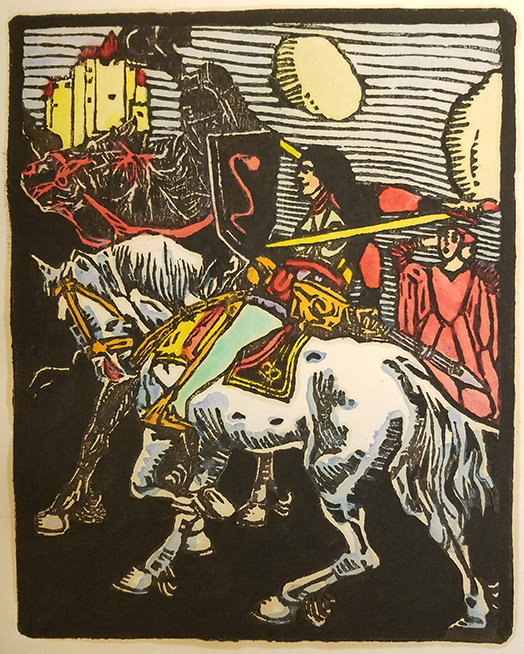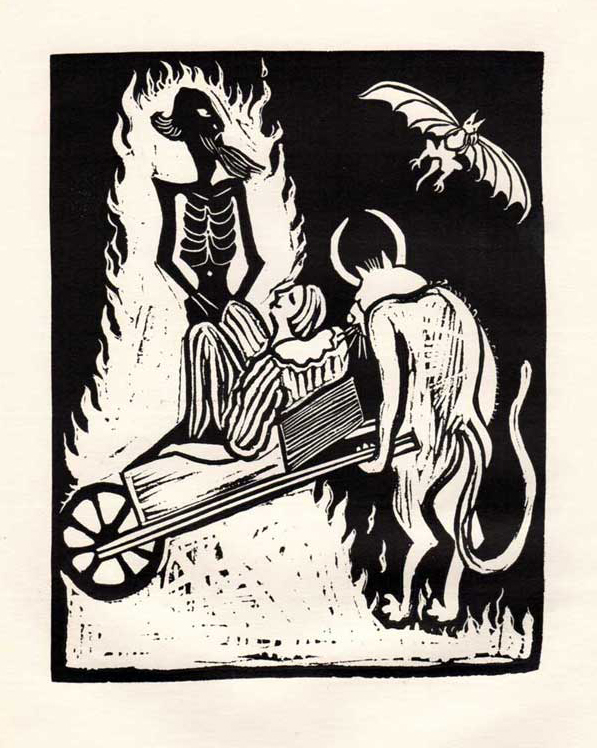
Special Collections and Archives, VCU Libraries
The rich imagery of Cabell’s writing inspired artists working in a variety of styles and media. The following list is not exhaustive, but the links will allow you to view representative examples of illustrations and artistic responses to Cabell’s work. A more extensive list of the major Cabell illustrators can be found in James N. Hall’s bibliography (pp. 173-177).

illustration for Jurgen: A Comedy of Justice by Frank C. Papé
Frank C Papé — Papé’s illustrations of Cabell’s books are the most well-known. Start with Jurgen: A Comedy of Justice.
Howard Pyle — The Line of Love, “The Story of Adhelmar” and other works. See also Chivalry where the frontispiece and eight of the color plates are by Howard Pyle; two plates are by William Hurd Lawrence; and one is by Elizabeth Shippen Green” (Thorne & Lloyd, An Illustrated Bibliography of Works By and About James Branch Cabell).
C. Coles Phillips (Coles Phillips) — frontispiece, The Cords of Vanity 1909.
Ray Frederick Coyle — Jurgen: A Comedy of Justice. R. M. McBride & Co., 1923.
John Buckland Wright — Jurgen: A Comedy of Justice. Golden Cockerel Press, 1949. An edition of 500 copies, with 16 original wood engravings by Wright.
William John Bernhard — Jurgen in Lino-cuts; Taboo, in Lino-cuts; The Jewel Merchants in Lino-cuts.

Samuel R. Ogden, artist. detail of plate from Twenty-two Plates from Cabell’s Jurgen
Image: Thorne and Lloyd, The Silver Stallion
Samuel R. Ogden — Twenty-two Plates from Cabell’s Jurgen [self-published], 1929.
Virgil Burnett — Jurgen: A Comedy of Justice. Limited Editions Club, 1976. Designed by Ted Gensamer in a limited edition of 2,000 copies.
James H. Wolf Althouse — The Judging of Jurgen, [privately published?], 192?
Leon Underwood — The Music from Behind the Moon: An Epitome. With eight wood engravings by Leon Underwood. The John Day Company, 1926.
Doris Lee — The St. Johns: A Parade of Diversities by Branch Cabell and A. J. Hanna. (Rivers of America series). Farrar & Rinehart, 1943.
Fabrizio Clerici — L’Incubo (The Nightmare Has Triplets, Italian ed.) Arnoldo Mondadori, 1949.
Rowland Wilson — Jurgen: A Comedy of Justice, Avon cover design, 1965.
Bob Pepper — Something About Eve, The Silver Stallion, Figures of Earth, Ballantine cover design, 1969-1971
James Branch Cabell himself created the Sigil of Scoteia for The Cream of the Jest: A Comedy of Evasions; a map of Poictesme, and the Kalki emblem of the stallion “rampant in every member.”

Rowland Wilson, cover artist
Image: Thorne and Lloyd, An Illustrated Bibliography of Works By and About James Branch Cabell

Bob Pepper, cover artist
Image: Thorne and Lloyd, An Illustrated Bibliography of Works By and About James Branch Cabell